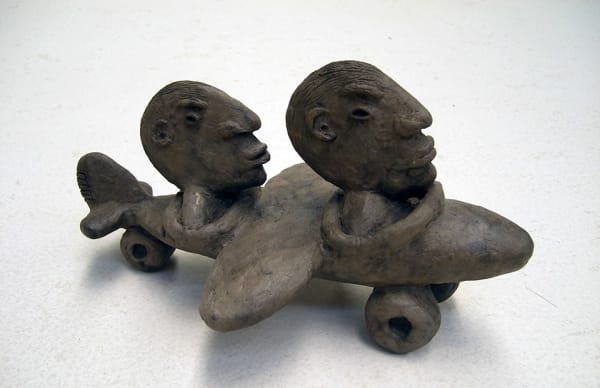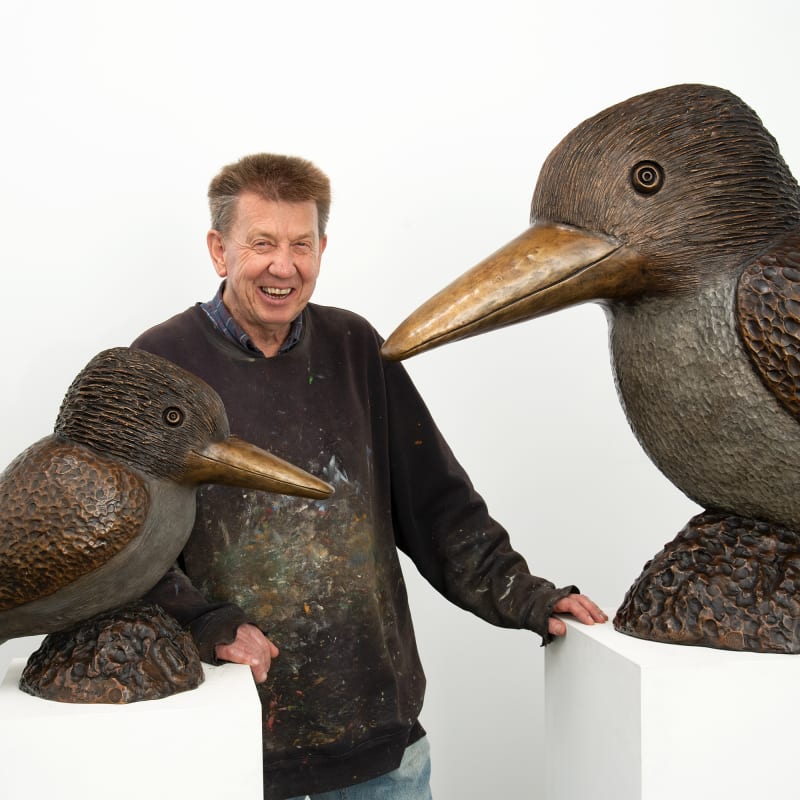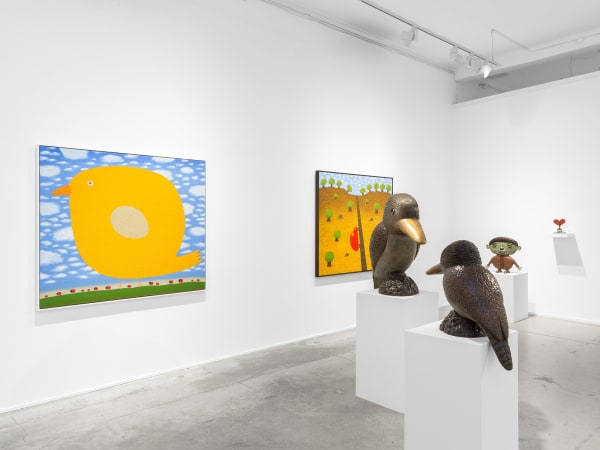Dean Bowen: Nitty Gritty
-
 Dean BowenBalancing Bird (Ladybird Highway), 2021oil on linen122 x 153 cm, 125 x 156 cm (framed)Sold
Dean BowenBalancing Bird (Ladybird Highway), 2021oil on linen122 x 153 cm, 125 x 156 cm (framed)Sold -
 Dean BowenAeroplane Boy (Umber Shirt), 2022bronze18 x 47 x 7 cmEdition of 9
Dean BowenAeroplane Boy (Umber Shirt), 2022bronze18 x 47 x 7 cmEdition of 9 -
 Dean BowenBaby Whale, 2020unique bronze42 x 50 x 7 cmSold
Dean BowenBaby Whale, 2020unique bronze42 x 50 x 7 cmSold -
 Dean BowenBird Watching Bumble Bee, 2014oil on board11 x 25 cm, 14 x 28 cm (framed)Sold
Dean BowenBird Watching Bumble Bee, 2014oil on board11 x 25 cm, 14 x 28 cm (framed)Sold -
 Dean BowenBoy with Kookaburras, 2021bronze18 x 48 x 14 cmEdition of 9 plus 1 artist's proof
Dean BowenBoy with Kookaburras, 2021bronze18 x 48 x 14 cmEdition of 9 plus 1 artist's proof -
 Dean BowenComet Pair, 2020oil on linen45 x 53 cm, 48.5 x 55.5 cm (framed)Sold
Dean BowenComet Pair, 2020oil on linen45 x 53 cm, 48.5 x 55.5 cm (framed)Sold -
 Dean BowenDriving Farmer, 2004-2008bronze17 x 41 x 13 cmEdition of 9
Dean BowenDriving Farmer, 2004-2008bronze17 x 41 x 13 cmEdition of 9 -
 Dean BowenEchidna, 2013bronze82 x 147 x 30 cmEdition of 6 plus 2 artist's proofs
Dean BowenEchidna, 2013bronze82 x 147 x 30 cmEdition of 6 plus 2 artist's proofs -
 Dean BowenEchidna (Baby), 2020bronze23 x 44 x 14 cmEdition of 9
Dean BowenEchidna (Baby), 2020bronze23 x 44 x 14 cmEdition of 9 -
 Dean BowenEchidna (Female), 2018bronze34 x 78 x 20 cmEdition of 9 plus 1 artist's proof
Dean BowenEchidna (Female), 2018bronze34 x 78 x 20 cmEdition of 9 plus 1 artist's proof -
 Dean BowenEchidna on my Head (Third Version), 2009bronze38 x 12.5 x 10 cmEdition of 9
Dean BowenEchidna on my Head (Third Version), 2009bronze38 x 12.5 x 10 cmEdition of 9 -
 Dean BowenEchidna with Bird, 2018bronze17 x 22 x 10 cmEdition of 9Sold
Dean BowenEchidna with Bird, 2018bronze17 x 22 x 10 cmEdition of 9Sold -
 Dean BowenEchidna with Playful Bird, 2020bronze20 x 48 x 13 cmEdition of 9
Dean BowenEchidna with Playful Bird, 2020bronze20 x 48 x 13 cmEdition of 9 -
 Dean BowenHighway Landscape with Echidnas, 2021oil on linen137 x 153 cm, 140 x 156 cm (framed)Sold
Dean BowenHighway Landscape with Echidnas, 2021oil on linen137 x 153 cm, 140 x 156 cm (framed)Sold -
 Dean BowenLadybird Landscape II, 2019oil on linen122 x 183 cm, 125 x 186 cm (framed)Sold
Dean BowenLadybird Landscape II, 2019oil on linen122 x 183 cm, 125 x 186 cm (framed)Sold -
 Dean BowenLittle Red, 2018mixed media assemblage57 x 48 x 7 cmSold
Dean BowenLittle Red, 2018mixed media assemblage57 x 48 x 7 cmSold -
 Dean BowenNocturnal Home (the Drifting Smoke), 2020oil on linen45 x 53 cm, 48 x 56 cm (framed)Sold
Dean BowenNocturnal Home (the Drifting Smoke), 2020oil on linen45 x 53 cm, 48 x 56 cm (framed)Sold -
 Dean BowenPerching Kookaburra with Echidna, 2021unique bronze55 x 74 x 19 cmSold
Dean BowenPerching Kookaburra with Echidna, 2021unique bronze55 x 74 x 19 cmSold -
 Dean BowenSmiling Kookaburra (Large), 2021bronze109 x 118 x 43 cmEdition of 6
Dean BowenSmiling Kookaburra (Large), 2021bronze109 x 118 x 43 cmEdition of 6 -
 Dean BowenSmiling Kookaburra (Small), 2021bronze58 x 62 x 23 cmEdition of 6 plus 3 artist's proofs
Dean BowenSmiling Kookaburra (Small), 2021bronze58 x 62 x 23 cmEdition of 6 plus 3 artist's proofs -
 Dean BowenSparrow Hawk, 2009lithograph56 x 75.5 cm, 81 x 99.5 cm (framed)Edition of 4 plus 4 artist's proofs
Dean BowenSparrow Hawk, 2009lithograph56 x 75.5 cm, 81 x 99.5 cm (framed)Edition of 4 plus 4 artist's proofs -
 Dean BowenThe Bright One, 2017oil on board15 x 20 cmSold
Dean BowenThe Bright One, 2017oil on board15 x 20 cmSold -
 Dean BowenThe Contented Parrot, 2021oil on linen122 x 153 cm, 125 x 156 cm (framed)
Dean BowenThe Contented Parrot, 2021oil on linen122 x 153 cm, 125 x 156 cm (framed) -
 Dean BowenThe Flyers (II) , 2005bronze12 x 20 x 14 cmEdition of 9
Dean BowenThe Flyers (II) , 2005bronze12 x 20 x 14 cmEdition of 9 -
 Dean BowenThe Home of Love, 2021oil on linen122 x 183 cm, 125 x 186 cm (framed)Sold
Dean BowenThe Home of Love, 2021oil on linen122 x 183 cm, 125 x 186 cm (framed)Sold -
 Dean BowenThe Home of Love (Red Cloud), 2021bronze25 x 25 x 11 cmEdition of 9 plus 1 artist's proof
Dean BowenThe Home of Love (Red Cloud), 2021bronze25 x 25 x 11 cmEdition of 9 plus 1 artist's proof -
 Dean BowenThe House of Love (Medium), 2019bronze37 x 19.5 x 8.5 cmEdition of 9
Dean BowenThe House of Love (Medium), 2019bronze37 x 19.5 x 8.5 cmEdition of 9 -
 Dean BowenThe House of Love (Tiny), 2019bronze21.5 x 17.5 x 9.5 cmEdition of 9
Dean BowenThe House of Love (Tiny), 2019bronze21.5 x 17.5 x 9.5 cmEdition of 9 -
 Dean BowenThe House of Love (Tiny), 2019bronze21.5 x 17.5 x 9.5 cmEdition of 9 (#5/9)Sold
Dean BowenThe House of Love (Tiny), 2019bronze21.5 x 17.5 x 9.5 cmEdition of 9 (#5/9)Sold -
 Dean BowenThe House of Many Windows, 2021oil on linen137 x 153 cm, 140 x 156 cm (framed)
Dean BowenThe House of Many Windows, 2021oil on linen137 x 153 cm, 140 x 156 cm (framed) -
 Dean BowenThe Little Man (Second State), 2020bronze31.5 x 27 x 7 cmEdition of 9
Dean BowenThe Little Man (Second State), 2020bronze31.5 x 27 x 7 cmEdition of 9 -
 Dean BowenYellow Canary, 2010oil on board100 x 100 cm, 103 x 103 cm (framed)
Dean BowenYellow Canary, 2010oil on board100 x 100 cm, 103 x 103 cm (framed) -
 Dean BowenYellow Canary with Ladybird Army, 2021oil on linen137 x 153 cm, 140 x 156 cm (framed)Sold
Dean BowenYellow Canary with Ladybird Army, 2021oil on linen137 x 153 cm, 140 x 156 cm (framed)Sold
The distinction between two-dimensional and three-dimensional works isn’t so straightforward for Dean Bowen. When we talk about his preparatory work for ‘Nitty-Gritty’, he tells me that his bronze sculptures have a special, twinkling kind of relation to the creatures in his paintings and prints. Many of Bowen's figures pop up, gleeful and enthusiastic, cascading across different media. Bowen says it’s often as if his bronze figures act like characters from his two-dimensional works come to life, and springing off the page into the space of the studio or gallery. It feels right to be discussing these figures as “personnages,” performing some secret and happy magic as they flit between flatness and fullness. Echidnas, owls, whales, and that other kind of person, the human being, have been ongoing figures of interest for Bowen, to which he has now been devoted for decades. A landmark survey show, ‘Nitty-Gritty’ celebrates twenty-five years of sculptural practice. Bowen’s bronze works are shown in concert with paintings, creating a joyful world entire. This is a generous realm, where small and simple pleasures are of the utmost importance, and the happenstances often overlooked in our busy lives are given bright, strident attention.
Bowen’s first thoughts towards making sculpture came while working in Paris in the early 1990s, in the atelier of the printer Franck Bordas. It was his findings in the atelier’s library, and the viewing of two pivotal survey exhibitions in the French capital – of Fernando Botero and Alberto Giacometti – which prompted Bowen’s expansion from printmaking into sculpture at this time. As Bowen has it, “One of my big heroes is Jean Dubuffet, whom Franck had printed for in the ‘80s. He had a good library of books on Dubuffet, and while I was waiting for the presses to start up and so on, I would read a lot of that library. I really felt I had to diversify my work. Thinking about Dubuffet and his approach to art, and seeing those two big survey exhibitions, the seed was really planted that I wanted to get into sculpture, I wanted to be more creative.”
Bowen’s formal inheritances from these European predecessors are clear: the rounded, cherubic forms of his painted birds from Botero, the long, lithe sculptural lines of Giacometti. But Bowen’s real inventiveness has been in the cues of spirit taken from each of these artists, and especially from Dubuffet. An affection for his subjects, a sense of humour and lightness, and an optimism which sees the generative potential in all of the life around him have underpinned Bowen’s appraisals and reappraisals of the creatures his art interacts with. Bowen’s connection to his “personages” is personal and playful – as is the connection between viewers and his works, in turn.
A working-down of the supposed divide between the “natural” world and the human one – created and made habitable by the poiesis of art – is one key function of Bowen’s optimism. Under his hand, animals, people, and even cars and houses all operate on the same affective planes, living together in the life-affirming imaginative space between two and three dimensions. Take, for example, The Home of Love, which nestles the human spirit – bright and stout, like Bowen’s painted lady-birds – snugly within the hill, the sky, and the encompassing love which surround it.
In this way, Bowen’s work weaves together environmentalism and an uplifted interest in our ordinary lives. Echidna on my Head for instance, shows a man and echidna sharing a gaze, a texture, and even an identity; Bowen comments that his personal identification with the animal stems from a comment his grandmother made about his spiky hair as a young man, making the work an interspecies double self-portrait. But this isn’t the only appeal of the echidna to Bowen, whose affection for the animal is also founded on a sense of its outsiderness – its strangeness, its unwillingness to conform to what others might expect, its luminous unlikelihood. Outsider Art has been, then, not only a formal but a conceptual inspiration for Bowen, who seeks to embrace the inventive, unusual, and the self-determined in animals and people alike.
The internationalism of Bowen’s influences is one side of his story; ongoing commitments to the minute, the haptic, and the local make up another. In fact, Bowen’s initial enthusiasm for international travel in the service of his artmaking has its roots at Maryborough Tech, where he remembers “being shown a book of Dubuffet’s drawings from MoMA in New York . . . Teachers planted the travel and art bug in me, right from fifteen. I wanted to see all these artworks that I’d only seen in magazines and books.” An attachment to the local also plays a material role in Bowen’s sculptural practice. Many of his whale sculptures are, in fact, made from casts of branches fallen from a favourite tree, which Bowen passes on his daily meanderings, collecting spoils as he goes. This could be the apotheosis of Bowen’s imaginative kneading through the “natural” world; a literal digging of fingers into the waft and wisp of it, working to produce something transposed.
The delight, humour, and fun of Bowen’s work are underpinned by a deep humanism, and a reparative belief in the potential for connection and love wherever we may find ourselves on earth. The figures in Bowen’s works need not even be traditionally “living” beings to be animated by this humanist ethos: Jar of Stars, for example, puts forward the potential of a reverse-Pandora’s Box. Curled and characterful stars, each unique in its gesture outwards from its heart-centre, are waiting within a jar to be released into the world. Except, of course, that they’re already here: visible, even touchable, on the surface on the sculpture, with us. Bowen’s figuration, here, is really a transfiguration: an approach to the world with curiosity in mind and hand, a leap between the imagined and the real, between media, between species, and between dimensions and states of matter.
Erin McFayden
Deputy Editor, Artist Profile







































